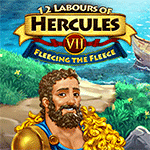
In his labours, Heracles was sometimes accompanied by a male companion (an eromenos), according to Licymnius and others, such as Iolaus, his nephew.

In each case, the pattern was the same: Heracles was sent to kill or subdue, or to fetch back for Eurystheus (as Hera's representative) a magical animal or plant.Ī famous depiction of the labours in Greek sculpture is found on the metopes of the Temple of Zeus at Olympia, which date to the 460s BC. Six others took the hero farther afield, to places that were, per Ruck, "all previously strongholds of Hera or the 'Goddess' and were Entrances to the Netherworld". Ruck and Staples assert that there is no one way to interpret the labours, but that six were located in the Peloponnese, culminating with the rededication of Olympia. Heracles's first six labours were located in the Peloponnese.Īs they survive, the labours of Heracles are not recounted in any single place, but must be reassembled from many sources. Heracles accomplished these tasks, but Eurystheus refused to recognize two: the slaying of the Lernaean Hydra, as Heracles' nephew and charioteer Iolaus had helped him and the cleansing of the Augean stables, because Heracles accepted payment for the labour (in other versions it was the Stymphalian Birds that was discounted instead of the Augean stables, for the help of Athena giving Heracles bronze rattles).Įurystheus thus set two more tasks (fetching the Golden Apples of Hesperides and capturing Cerberus), which Heracles also performed, bringing the total number of tasks to twelve. Eventually, Heracles placed himself at Eurystheus's disposal.Įurystheus originally ordered Heracles to perform ten labours. Heracles despaired at this, loathing to serve a man whom he knew to be far inferior to himself, yet fearing to oppose his Zeus. Pythia, the Oracle of Delphi, advised him to go to Tiryns and serve his cousin, King Eurystheus of Mycenae, for ten years, performing whatever labours Eurystheus might set him in return, he would be rewarded with immortality. Although, according to Euripides in Herakles, it was not until after Heracles had completed his labours and on his return from the Underworld that he murdered Megara and his children.Īfter recovering his sanity, Heracles deeply regretted his actions he was purified by King Thespius, then traveled to Delphi to inquire how he could atone for his actions. However, in a fit of madness induced by Hera, Heracles killed Megara and their children. Heracles married King Creon of Thebes' eldest daughter, Megara. Astonished, Amphitryon sent for the seer Tiresias, who prophesied an unusual future for the boy, saying he would vanquish numerous monsters. He was found by his nurse playing with them on his cot as if they were toys.

Iphicles cried from fear, but his twin brother grabbed a snake in each hand and strangled them. He and his mortal twin, Iphicles, were just eight months old when Hera sent two giant snakes into the children's chamber. The child was originally given the name Alcides by his parents it was only later that he became known as Heracles in an unsuccessful attempt to mollify Hera, with Heracles meaning Hera's "pride" or "glory". Either Zeus or Athena brought the infant back to his mother, and he was subsequently raised by his parents. But with divine milk, Heracles had acquired supernatural strength. Heracles suckled so strongly that he caused Hera pain, she pushed him away, and her milk sprayed across the heavens, forming the Milky Way. Alcmene's fear towards his wife Hera led her to expose her infant son, who was taken by either Zeus or his daughter Athena (the protectress of heroes) to Hera, who did not recognize Heracles and nursed him out of pity. Heracles was the son of the affair Zeus, the king of the gods, had with the mortal woman Alcmene disguised as her husband Amphitryon. The Origin of the Milky Way by Jacopo Tintoretto, 1575
#12 labours of hercules fleecing level 3.1 series#
During this time, he was sent to perform a series of difficult feats, called labours.

Heracles was told to serve Eurystheus, king of Mycenae, for ten years. Afterwards, Heracles went to the Oracle of Delphi to atone, where he prayed to the god Apollo for guidance. Having tried to kill Heracles ever since he was born, Hera induced a madness in him that made him kill his wife and children. The establishment of a fixed cycle of twelve labours was attributed by the Greeks to an epic poem, now lost, written by Peisander, dated about 600 BC. The episodes were later connected by a continuous narrative. They were accomplished at the service of King Eurystheus. The Labours of Hercules or Labours of Heracles ( Greek: οἱ Ἡρακλέους ἆθλοι, hoì Hērakléous âthloi, Latin: Herculis Labores) are a series of episodes concerning a penance carried out by Heracles, the greatest of the Greek heroes, whose name was later romanised as Hercules.


 0 kommentar(er)
0 kommentar(er)
